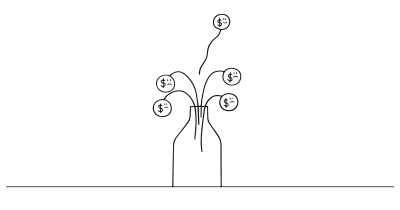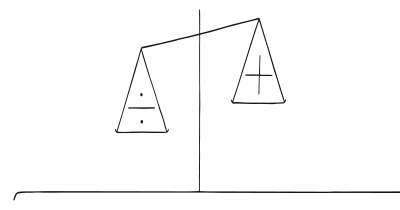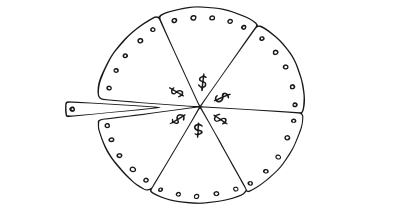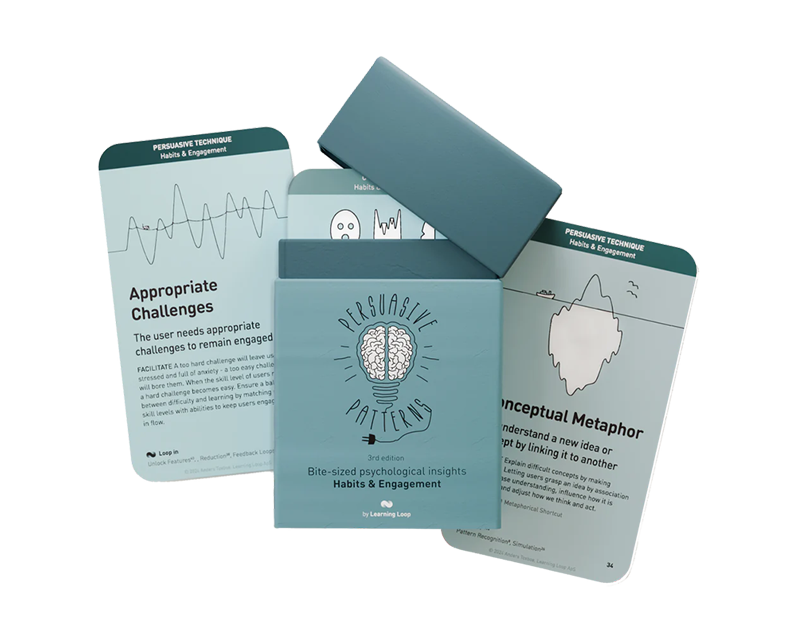Persuasive Patterns: Education
Inaction Inertia Effect
We are less likely to buy having previously missed a more attractive offer

The Inaction Inertia Effect highlights a behavioral quirk in our decision-making process. When presented with a series of choices, if we initially encounter a very attractive offer (e.g., a discount) and then miss out on it, we become less likely to act favorably on subsequent, less appealing options. This can manifest in various ways, from abandoning the purchase altogether to opting for a lower-priced (but potentially less satisfying) alternative.
Imagine you’re browsing an online clothing store. You come across a fantastic deal on a jacket you’ve been eyeing – a limited-time discount of 50% (highly attractive offer). Unfortunately, you hesitate and miss the sale window. Later, browsing the same store, you see the jacket again, but now at its full price (less appealing option). Research suggests you might be less likely to purchase the jacket at full price, even though it’s still the same item you initially desired. This reluctance to act stems from the Inaction Inertia Effect – having missed the better deal, you experience a sense of inertia and are less inclined to engage with subsequent, less attractive options.
Similarly, many streaming services offer free trial periods (highly attractive offer). If you miss the signup window for the free trial and then consider subscribing later, you might be less likely to do so at the full monthly price (less appealing option). Understanding the Inaction Inertia Effect allows streaming services to strategically present their offers. By highlighting the value proposition of the free trial upfront, they nudge users to take advantage of it before the window closes and potentially experience the inertia of a missed opportunity.
The jam experiment
A seminal study by Inman, Krishna, and Peters (2009) investigated how the order of options we encounter can influence our choices. They conducted a supermarket experiment where participants were presented with jams. Some participants first saw a display with a particularly attractive discount on a specific jam (highly attractive option). If they didn’t choose that jam, they were then given the chance to buy another jam at its regular price (less appealing option). The researchers compared this group to a control group who only saw the jams at their regular prices. The results were striking: a whopping 78% of participants who missed out on the discounted jam were less likely to subsequently purchase another jam at full price, compared to only 34% in the control group. This study highlights the Inaction Inertia Effect – the tendency to become less likely to act favorably on subsequent options after missing out on an attractive deal early on.
Inman, J. J., Krishna, A., & Peters, E. (2009). Inertia sellers. Journal of Marketing Research, 46(3), 392-402.
The Inaction Inertia Effect is rooted in the well-established psychological principle of loss aversion. Loss aversion refers to our tendency to perceive losses more intensely than gains of equivalent value. When we miss out on a particularly attractive offer, we experience a sense of loss, a negative emotional response. This Negativity Bias, as psychologists call it, can linger and influence our subsequent decision-making.
Faced with a less appealing option, the potential loss of not acting (having missed out on an even better deal previously) outweighs the potential gain (acquiring the less desirable option) in our minds. This aversion to loss effectively creates inertia, making us less likely to take action on subsequent choices, even if the option itself might hold some value.
The emotional response to the missed opportunity disrupts our rational evaluation of the remaining options. We become fixated on the loss we experienced and struggle to objectively assess the value proposition of the remaining choices. This highlights the interplay between emotions and rationality in our decision-making processes.
Designing products about the Inaction Inertia Effect
Understanding how users react to missed opportunities offers a powerful tool for product designers.
The order in which we present choices matters. Imagine a user browsing a fitness app. A prominently displayed, limited-time discount on the premium membership sets an initial expectation (anchoring). When the offer expires, users might be more likely to consider the standard membership, now seemingly less appealing in comparison, than if they’d encountered it first. This initial, attractive offer becomes the reference point.
The ultimate goal shouldn’t be short-term conversions at the expense of long-term user satisfaction. Freemium models with limited free trials exemplify ethical use. By experiencing the app’s value firsthand, users might be more receptive to a paid plan after the free trial ends. The missed opportunity (the trial’s conclusion) nudges them towards a decision that ultimately benefits them.
Repeated aggressive discounting can lead users to expect unreasonably low prices. Finding the right balance between attracting users and maintaining profitability is essential. How you design offers matters too. The timeframe and ease of obtaining the discount should be clear, with strategies to encourage users who haven’t immediately acted.
Ethical recommendations
The Inaction Inertia Effect offers a powerful tool for influencing user behavior, but like any persuasive pattern, it requires responsible application. When used unethically, it can manipulate users into decisions that ultimately don’t benefit them. Let’s explore some potential pitfalls to avoid.
Deceptive tactics can erode user trust. Imagine a countdown timer displayed prominently next to a discounted product, creating a false sense of urgency. This tactic might nudge a purchase, but if the timer resets frequently or the “limited quantity” claim is misleading (e.g., “Only 3 left!” when there’s ample stock), user trust plummets. Similarly, overly aggressive discount strategies that pressure users into immediate purchases through FOMO (fear of missing out) can backfire. Bombarding users with constant discount notifications or framing limited-time offers in a way that emphasizes potential loss (“Don’t miss out!”) creates a negative user experience.
Failing to clearly communicate the limitations and conditions of limited-time offers can mislead users and breed frustration. Imagine a user enticed by a “free trial” offer, only to discover hidden fees or a complicated cancellation process after signing up. This lack of transparency not only discourages the user from continuing, but also damages the company’s reputation. Furthermore, unsustainable pricing strategies can have long-term consequences. Repeated, aggressive discounting might initially attract users, but it can set unrealistic price expectations. If a company relies solely on these tactics, it becomes difficult to maintain a healthy business model in the long run. This ultimately harms both the company and its customers, as the company might struggle to offer the quality of service or product users expect at the unsustainable discounted price.
To accommodate for these ethical pitfalls, consider adopting these recommendations:
- Be transparent
Clearly communicate the timeframe and limitations of limited-time offers. Allow users to opt-out of future notifications to maintain control over their experience. - Focus on creating value
Pair the Inaction Inertia Effect with offers that genuinely benefit users in the long run. Don’t prioritize short-term conversions over user satisfaction. - Adopt a sustainable pricing strategy
Develop a pricing strategy that balances attracting users with maintaining profitability without resorting to manipulative discounting practices. - Respect user choice
Nudge users towards desired actions, but don’t force them. Provide clear information and allow them to make informed decisions.
Real life Inaction Inertia Effect examples
Spotify
Spotify offers a free month of their premium service, allowing users to experience ad-free music and on-demand listening. After the trial ends, users might be more likely to subscribe to maintain access to these features, demonstrating the Inaction Inertia Effect.
E-commerce
Offering free shipping above a certain purchase amount encourages customers to add more items to their cart to qualify for the free shipping benefit. This strategy increases average order value and can nudge customers towards higher spending.
Travel Booking Sites
Travel booking sites might initially display a discounted room rate with a countdown timer. This “limited-time offer” creates an anchor point, making the regular price (which might still be competitive) seem more reasonable in comparison.
Trigger Questions
- Could an attractive introductory offer prime users for a less-appealing, but ultimately more sustainable, option?
- How can we clearly communicate limited-time offers?
- Will users genuinely benefit from the option they might convert to after missing the initial offer?
- Are we avoiding aggressive discounting that sets unrealistic price expectations?
- How can we encourage action on limited-time offers?
- Can we subtly vary product characteristics to discourage direct price comparisons?
- Could size or seasonal variations mitigate anchoring effects?
Pairings
Inaction Inertia Effect + Social Proof
Highlighting the number of users who have taken advantage of a limited-time offer (Social Proof) alongside the offer itself (Inaction Inertia) creates a powerful persuasive force. Imagine a travel booking site showcasing a limited-time discount (Inaction Inertia) with a social proof element like “Join the 1,000 travelers who snagged this deal!” This combination leverages the fear of missing out (FOMO) and the desire to conform to social behavior.

We are less likely to buy having previously missed a more attractive offer

We assume the actions of others in new or unfamiliar situations
Inaction Inertia Effect + Scarcity Bias
Limited quantities paired with limited-time offers can significantly increase the perceived value of an option. For example, an e-commerce store offering a flash sale on a popular item with “only 10 left in stock!” creates a sense of urgency, nudging users towards a purchase before they miss out (Inaction Inertia) on this scarce opportunity.

We are less likely to buy having previously missed a more attractive offer

We value something more when it is in short supply
Inaction Inertia Effect + Loss Aversion
People are more sensitive to potential losses than gains. Combining this with Inaction Inertia can be effective. Imagine a music streaming service highlighting the exclusive features users will lose if they miss a limited-time free trial upgrade (Inaction Inertia) – tapping into their aversion to giving up the benefits they’ve already experienced.

We are less likely to buy having previously missed a more attractive offer

Our fear of losing motivates us more than the prospect of gaining
Inaction Inertia Effect + Framing Effect
Framing affects how users perceive information. Pairing Inaction Inertia with positive framing can be persuasive. For instance, a fitness app might offer a limited-time discount on a premium membership framed as “unlock your fitness goals for 20% off” (Inaction Inertia + positive framing). This approach emphasizes the value gained rather than the potential loss of the discount.

We are less likely to buy having previously missed a more attractive offer

The way a fact is presented greatly alters our judgment and decisions
Inaction Inertia Effect + Endowment Effect
The Endowment Effect describes our tendency to value things we already own more than things we don’t. This can be paired with Inaction Inertia strategically. A project management tool might offer a free trial (Endowment Effect) – allowing users to experience the value firsthand. Once the trial ends, the Inaction Inertia Effect can nudge them towards a paid subscription to retain access to their “owned” projects.

We are less likely to buy having previously missed a more attractive offer

We value objects more once we feel we own them
Inaction Inertia Effect + Authority Bias
Leverage the trust users place in authority figures alongside limited-time offers. Imagine an educational platform showcasing a course endorsed by a renowned expert, with a limited-time discount. This combination taps into users’ desire to learn from credible sources and the fear of missing out on a valuable opportunity.

We are less likely to buy having previously missed a more attractive offer

We have a strong tendency to comply with authority figures
Inaction Inertia Effect + Commitment & Consistency
People tend to follow through on commitments they’ve made. Pair this with Inaction Inertia for a powerful duo. For instance, a language learning app might offer a discounted annual subscription with a small initial payment followed by recurring payments. The initial commitment increases the likelihood users will continue, and the Inaction Inertia Effect discourages them from canceling after experiencing the initial value.

We are less likely to buy having previously missed a more attractive offer

We want to appear consistent with our stated beliefs and prior actions
Inaction Inertia Effect + Liking Bias
We tend to be more receptive to people or products we like. Combine this with Inaction Inertia to create a persuasive nudge. Imagine a clothing store offering a discount on a stylist-curated outfit suggestion for users who’ve previously interacted with the stylist and presenting it as a limited-time offer. This leverages the positive experience with the stylist and the fear of missing out on a personalized deal.

We are less likely to buy having previously missed a more attractive offer

We prefer to say yes to the requests of someone we know and like
Inaction Inertia Effect + Delay Discounting
People tend to value immediate rewards more than future ones. Pairing this with Inaction Inertia can be strategic. For instance, a productivity app might offer early access to premium features (immediate reward) to users who upgrade before the official launch. This combination caters to the preference for immediate benefits and encourages early adoption.

We are less likely to buy having previously missed a more attractive offer

We tend to choose smaller immediate rewards over larger, later rewards
Inaction Inertia Effect + Curiosity Effect
Curiosity motivates exploration. Use this alongside Inaction Inertia to pique user interest. For example, a news platform might offer a limited-time free trial with access to exclusive content after users have read a few free articles (Inaction Inertia). This strategy leverages users’ natural curiosity and the fear of missing out on valuable content.

We are less likely to buy having previously missed a more attractive offer

We crave more when teased with a small bit of interesting information
A brainstorming tool packed with tactics from psychology that will help you build lasting habits, facilitate behavioral commitment, build lasting habits, and understand the human mind. It is presented in a manner easily referenced and used as a brainstorming tool.
Get your deck!- Inaction inertia by Zeelenberg, et. al.
- Inaction inertia by van Putten, Zeelenberg, van Dijk, & Tykocinski
- Inaction Inertia Effect
- Inman, J. J., Krishna, A., & Peters, E. (2009). Inertia sellers. Journal of Marketing Research, 46(3), 392-402.
- Zeelenberg, M., Nijstad, B. A., van Putten, M., & van Dijk, E. (2006). Inaction inertia, regret, and valuation: A closer look. Organizational Behavior and Human Decision Processes, 101(1), 89–104
- van Putten, M et al (2013). Inaction inertia, European Review of Social Psychology, 24(1), 123–159
- Liu, H.-H. and Chou, H.-Y. (2021), Effects of comparability of promotions on inaction inertia, Marketing Intelligence & Planning, Vol. 39 No. 1, pp. 125-139.
- Iyengar, S. S., & Lepper, M. R. (2000). When choice undermines quality: The limited utility of choice. Journal of Personality and Social Psychology, 79(6), 993-1006.
- Nowlis, S. M., & Simonson, I. (2005). Cuteness and the negative bias: Feeling good about feeling bad. Journal of Experimental Social Psychology, 41(4), 455-462.
- Kahneman, D., & Tversky, A. (1979). Prospect theory: An analysis of decision under risk. Econometrica, 47(2), 263-291.
- Arkesa, D., Kung, L., & Hutzel, L. (2002). Underanchoring and the illusion of choice in consumer decision making. Journal of Consumer Research, 29(2), 213-228.

